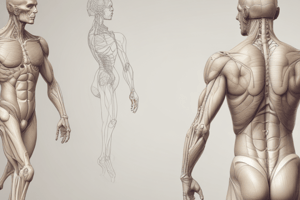Podcast
Questions and Answers
What can result in extended periods of immobilization?
What can result in extended periods of immobilization?
- Fractures
- Surgery
- Paralysis
- All of the above (correct)
What effect does immobilization have on bone density?
What effect does immobilization have on bone density?
- Does not affect bone density
- Increases bone density
- Causes bone deformities
- Reduces bone density (correct)
What happens to articular cartilage due to immobilization?
What happens to articular cartilage due to immobilization?
- It reduces in thickness and stiffness (correct)
- It becomes thicker and stiffer
- It remains unaffected
- It becomes more flexible
What is the result of excessive collagen fiber cross-links?
What is the result of excessive collagen fiber cross-links?
Which type of muscle fibers exhibit greater atrophy due to immobilization?
Which type of muscle fibers exhibit greater atrophy due to immobilization?
What is the effect of prolonged immobilization on regional osteoporosis?
What is the effect of prolonged immobilization on regional osteoporosis?
What does AROM stand for in the context of exercise?
What does AROM stand for in the context of exercise?
Which type of exercise is used to maintain the normal range of joint motion?
Which type of exercise is used to maintain the normal range of joint motion?
What is one of the goals of active free exercises?
What is one of the goals of active free exercises?
What is the starting position for active free exercises?
What is the starting position for active free exercises?
Which factor increases during prolonged active free exercise, leading to the production of heat and increasing circulation?
Which factor increases during prolonged active free exercise, leading to the production of heat and increasing circulation?
What is the purpose of teaching instructions for active free exercise?
What is the purpose of teaching instructions for active free exercise?
Which of the following is NOT a goal of active free exercises?
Which of the following is NOT a goal of active free exercises?
What is the primary purpose of teaching instructions for active free exercises?
What is the primary purpose of teaching instructions for active free exercises?
Which type of exercise is classified as 'localized' in active free exercises?
Which type of exercise is classified as 'localized' in active free exercises?
What is the effect of prolonged active free exercise on circulatory and respiratory cooperation?
What is the effect of prolonged active free exercise on circulatory and respiratory cooperation?
How does relaxation play a role in active free exercises?
How does relaxation play a role in active free exercises?
What is the purpose of the starting position in active free exercises?
What is the purpose of the starting position in active free exercises?
What is the primary factor influencing the speed at which exercise should be done?
What is the primary factor influencing the speed at which exercise should be done?
How does prolonged immobilization impact articular cartilage?
How does prolonged immobilization impact articular cartilage?
What is the consequence of muscle tissue atrophy and contracture?
What is the consequence of muscle tissue atrophy and contracture?
In the context of exercising, what is the impact of extended periods of immobilization on bone density?
In the context of exercising, what is the impact of extended periods of immobilization on bone density?
What is the main cause of regional osteoporosis during prolonged immobilization?
What is the main cause of regional osteoporosis during prolonged immobilization?
What happens to slow-twitch muscle fibers compared to fast-twitch fibers due to immobilization?
What happens to slow-twitch muscle fibers compared to fast-twitch fibers due to immobilization?
Flashcards are hidden until you start studying
Study Notes
Effects of Immobilization
- Extended periods of immobilization can result in muscle tissue atrophy and contracture.
- Immobilization causes a decrease in bone density.
- It leads to articular cartilage degradation and loss of function.
- Immobilization results in regional osteoporosis, particularly in the affected area.
Muscular Effects
- Immobilization causes muscle fibers to atrophy, with slow-twitch fibers exhibiting greater atrophy compared to fast-twitch fibers.
- Excessive collagen fiber cross-links occur due to immobilization, leading to muscle stiffness and loss of function.
Active Free Exercises
- AROM stands for Active Range of Motion in the context of exercise.
- Active free exercises are used to maintain the normal range of joint motion.
- One of the primary goals of active free exercises is to maintain or improve joint mobility.
- The starting position for active free exercises is typically a neutral position.
- Muscle relaxation plays a crucial role in active free exercises, allowing for more effective movement.
- The primary purpose of teaching instructions for active free exercises is to ensure proper execution and minimize injury risk.
- The primary factor influencing the speed at which exercise should be done is the individual's comfort level and muscle control.
Physiological Effects
- Prolonged active free exercise increases heart rate, leading to increased circulation and heat production.
- Circulatory and respiratory cooperation improves with prolonged active free exercise.
- The starting position in active free exercises helps to establish a foundation for movement, reducing muscle strain and promoting proper execution.
Osteoporosis and Cartilage
- Regional osteoporosis is a consequence of prolonged immobilization, particularly in the affected area.
- Immobilization leads to articular cartilage degradation and loss of function.
- Prolonged immobilization results in decreased bone density, making the individual more susceptible to osteoporosis.
Studying That Suits You
Use AI to generate personalized quizzes and flashcards to suit your learning preferences.




